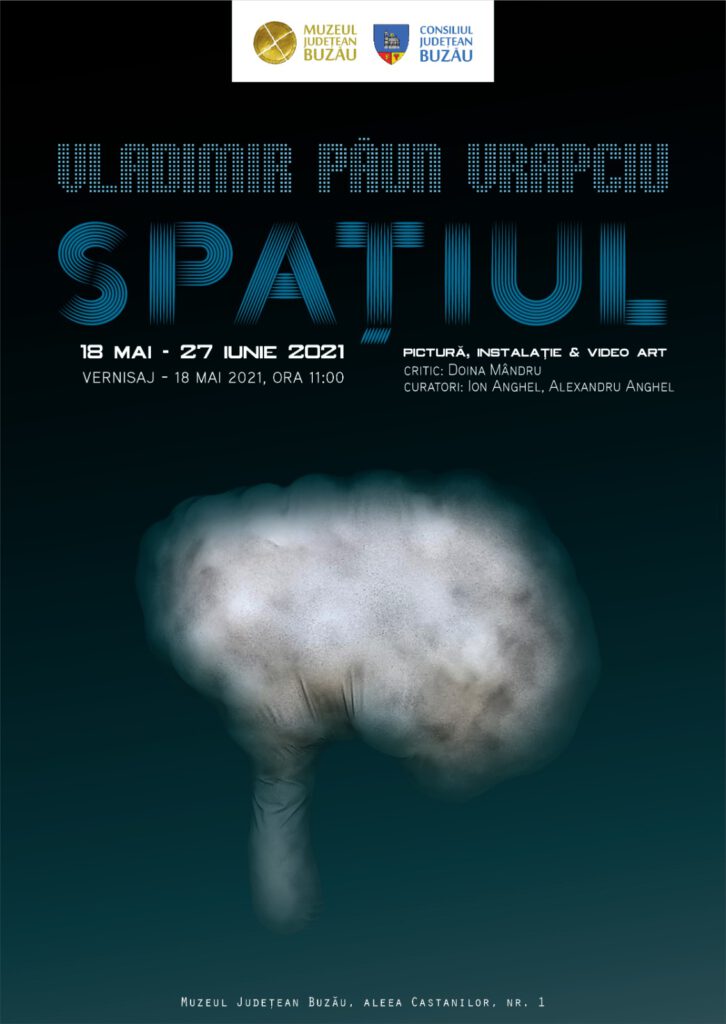Exhibition of painting, installation and video art “Space”
Communiqué
Deschiderea expoziţiei „Spațiul”
Muzeul Judetean Buzau, instituție de cultură și cercetare ce funcționează sub autoritatea Consiliului Județean Buzău, găzduiește, în perioada 18.05.2021 – 27.06.2021, expoziția de pictură, instalație şi video art „Spaţiul”, cu lucrări semnate de artistul și arhitectul Vladimir Păun-Vrapciu; curatori: Ion Anghel şi Alexandru Anghel; Critic şi istoric de artă: Doina Mândru.
Deschiderea expoziției va avea loc marți, 18 mai 2021, începând cu ora 11:00, la sediul central al Muzeului Județean Buzău.
About this exhibition project, the author confesses:
The vision of the exhibition “Space” starts on March 15, on the 41st day of total closure in the interior space of my home in Bucharest, as a result of the restrictions imposed by the authorities due to the pandemic.
This was the moment when the human spirit began to develop the idea of finding a solution through which it could protect the human body from an unseen danger. A feeling of panic, followed by a sense of self-defense and self-protection.
The created forms, presented in the exhibition “Space”, were born in my mind as a vision of an organic form that will ensure the protection of the human soul, so that it can circulating freely, in order to rediscover the lost spaces in the universe, which remained to be discovered.
The human spirit has always had an unbridled desire to conquer space, regardless of its terrestrial or spatial form.
Terrestrial space has been a continuous challenge since ancient times, which was conquered by wars led by fearless rulers such as Alexander the Great, Attila ruler of the Hun or Juius Caesar in the Roman Empire, etc.
The need for knowledge and discovery of terrestrial space has made the human spirit go further and cross the oceans, as Christofor Columbus did, discovering an extremely important terrestrial space for humanity such as the American continent.
The cosmic space, spirit and the human body have reached an unimaginable distance in the conquest of space through cosmonauts such as Yuri Gagarin in the USSR (the first man in space) and Neil Armstrong in the USA (the first man to reach the moon).
“The (presupposed) properties of space have been a controversial subject of the scholars of all time. They vary depending on the degree of development of the knowledge accumulated by mankind throughout the various historical periods.
- Space is today considered a philosophical category that designates objective and universal forms of matter in motion. Unity with matter determines the infinite character of space and the eternity of time.
- El are trei dimensiuni bidirecționale, spre deosebire de categoria înrudită a timpului, care are o singură dimensiune și se scurge într-o singură direcție – numai înainte.
- The ancient atomists (Democrit and Epicur) regarded space as a vacuum and infinite receptor of material atoms.
- Aristotle believed that space is the sum of the places that the bodies occupy, and that both matter and space would be finite.
- The atomic conception of space and time (which also underlies Euclid's geometry) was developed in modern philosophy by Newton. For Newton space and time are absolute, objective and universal, so independent of matter in motion.
- Engels believes that the basic forms of any existence are space and time, and that an existence outside of time is an absurdity as large as one outside the space.
- Philosophers like Berkeley, Hume, Mach, Bergson deny the objectivity of space and time, relying on human consciousness or as subjective forms of his subjective experiences.
- Kant believes that the two categories are a prioritical forms of human sensitivity.
- Hegel considers space and time to be two categories of absolute idea.
- The formation of non-euclysal geometry by Lobabbsky, Bolyai, Gauss, Riemann contributed to the formation of conception after which the spatial geometric properties are not everywhere, being determined by the physical properties. Space is therefore inhomogeneous and anisotropic.
- Einstein’s theory of relativity (also called the physical theory of space and time) has demonstrated that the spatial-temporal properties (body length and duration of events) depend on the speed of movement of material systems, and that the structure or properties of the space-time continuum vary depending on the concentration of the masses of the substance and the intensity of the gravitational field generated by them.
- “Timpul şi spaţiul sunt moduri în care gândim şi nu moduri în care trăim.”
Albert Einstein
We are waiting for you at the museum!

